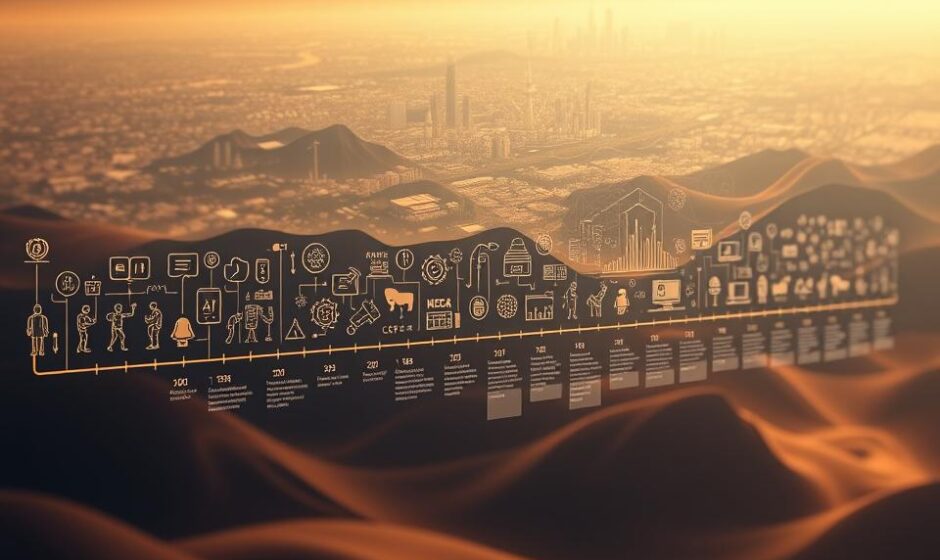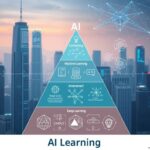Did you know the first known mechanical automaton was built over 2,000 years ago? Ancient Greek engineer Hero of Alexandria designed self-operating temple doors and steam-powered figures. This shows how long humans have been interested in artificial intelligence.
The journey of AI has come a long way from those early wonders. Today, we have self-driving cars and chatbots. This path shows how myths and logic debates turned into the algorithms that shape our world.
From Ada Lovelace’s 19th-century algorithms to the 1956 Dartmouth Conference, each step has shaped modern technology.
Key Takeaways
- The term “Artificial Intelligence” was born in 1956 at a key academic meeting.
- Automatons like Hero’s creations set the stage for computational thinking long before computers.
- AI’s growth combines ancient philosophy with today’s data science.
- Early AI pioneers faced challenges but kept improving, like with neural networks.
- The history of AI shows our ongoing effort to mimic and improve intelligence.
Foundations and Early Concepts
The journey of artificial intelligence development timeline started long before computers were invented. Ancient cultures dreamed of smart machines through myths and experiments. These early ideas set the stage for future breakthroughs.
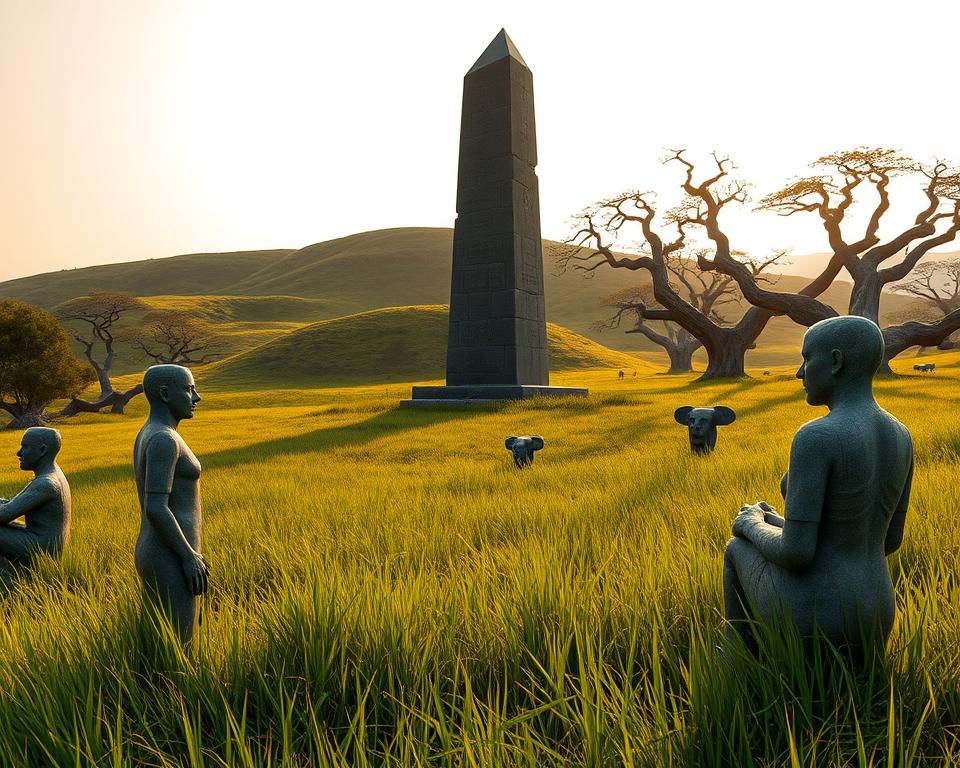
Ancient Inspirations: Myths and Machines
Myths like Hephaestus’s automaton servants in Greek stories and the bronze robot Talos from Crete hinted at machines with a purpose. These tales wondered if tools could ever think. Engineers like Hero of Alexandria built steam-powered figures in the 1st century CE, showing an early interest in mechanical smarts.
- Greek myths: Automatons in Hephaestus’s workshop
- Hero’s Aeolipile: First steam-powered device
- Talos: Legendary Cretan bronze guardian
The Birth of Computational Thought
Later, philosophers and mathematicians turned myths into real theories. René Descartes compared minds to “clockwork” in 1637. Ada Lovelace saw Charles Babbage’s Analytical Engine as a machine that could think creatively in 1843. These ideas mixed imagination with math, shaping the artificial intelligence development timeline.
- Descartes: “Animal spirits” and mechanical metaphors
- Lovelace: First computer programmer; foresaw algorithmic creativity
- Babbage’s engine: Mechanical precursor to modern computers
Pioneering Figures in AI Development
Every ai breakthroughs has a story behind it. Visionaries like Alan Turing, John McCarthy, and Marvin Minsky paved the way. They did this through endless curiosity and innovation.
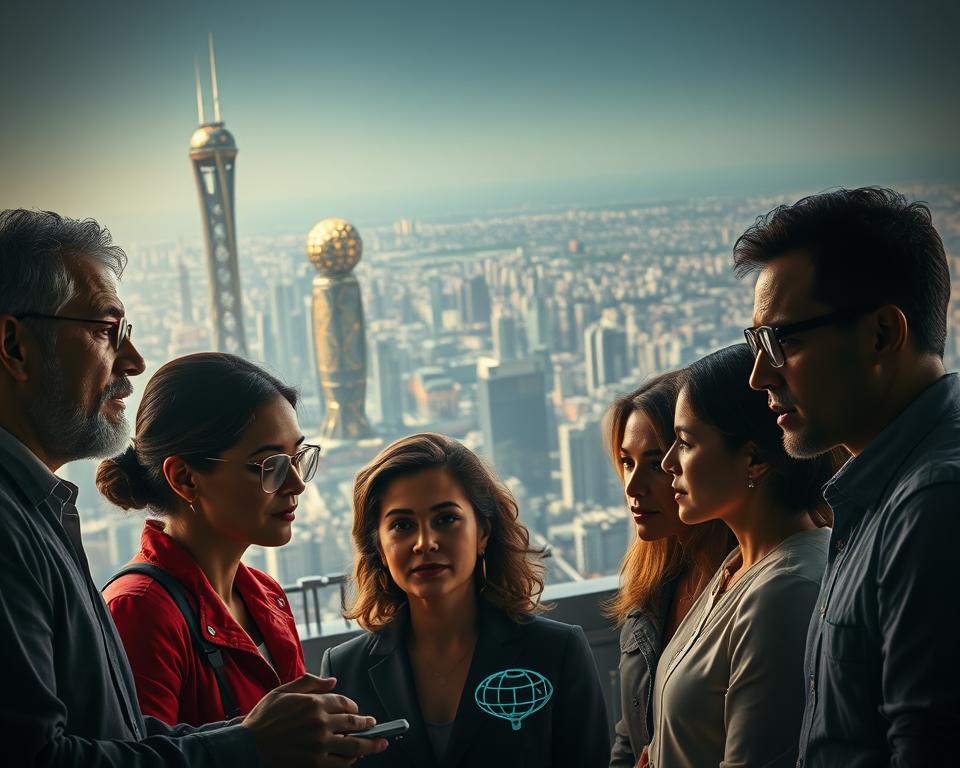
- Alan Turing: Proposed the Turing Test in 1950, a landmark in evaluating machine intelligence.
- John McCarthy: Coined the term “Artificial Intelligence” in 1955 and organized the Dartmouth Conference, where AI was officially born.
- Marvin Minsky: Co-founded the MIT AI Lab and pioneered neural network research, blending psychology and computing.
| Name | Breakthrough | Impact |
|---|---|---|
| Alan Turing | Turing Test | Set a standard for measuring machine intelligence. |
| John McCarthy | Dartmouth Conference (1956) | Led to first coordinated AI research efforts. |
| Marvin Minsky | Early neural networks | Laid groundwork for modern machine learning. |
“We’re seeking to build a machine that can engage in complex thought.” — Marvin Minsky
These visionaries turned big ideas into science. Their work led to the first AI programs. Without them, we wouldn’t have today’s tech like voice assistants and self-driving cars.
Their legacy shows that even the most abstract ideas can become real. It all comes down to persistence.
Charting the History of AI: Breakthroughs and Innovations

AI’s journey is filled with key moments that changed its path. In the 1970s, MYCIN showed AI could do medical diagnosis like a human. This was the start of AI’s ability to solve specific problems with logic.
Defining Moments and Technological Leaps
In 1997, IBM’s Deep Blue beat chess champion Garry Kasparov. This win showed AI’s power in complex tasks. Ten years later, Google’s AlphaGo won at Go, showing AI’s ability to learn and adapt.
Milestone Inventions and Discoveries
Deep learning changed everything. It used brain-like neural networks for big wins in image and language tasks. Companies like OpenAI and NVIDIA pushed these models to new heights.
| Year | Innovation | Impact |
|---|---|---|
| 1956 | Dartmouth Conference | Coined “AI” as a field |
| 1997 | Deep Blue’s Chess Win | Global recognition of AI capabilities |
| 2012 | ImageNet Challenge | Convolutional neural networks revolutionized visual recognition |
Every step, from rule-based systems to neural networks, shows AI’s growth. These milestones are part of a never-ending journey to smarter AI. As AI keeps evolving, these achievements light the way for its future.
Artificial Intelligence Development Timeline
AI’s journey spans decades, filled with breakthroughs and setbacks. The significant milestones in ai highlight how innovation often comes after periods of reassessment. This timeline marks key moments that changed the field’s path.

Decades of Innovation
AI has grown in different ways over the years:
- 1950s: Dartmouth Conference (1956) sets AI as a scientific field.
- 1980s: Expert systems start making decisions in healthcare and finance.
- 2010s: Big data and GPUs lead to big advances in image and speech recognition.
Periods of Rapid Growth and Setbacks
AI’s progress wasn’t smooth. Milestones like IBM’s Deep Blue (1997) and Google’s AlphaGo (2016) show the field’s leaps. But funding drops in the 1970s and 1990s slowed things down. These challenges led to more practical research.
| Year | Event | Impact |
|---|---|---|
| 1956 | Dartmouth Conference | Formalized AI research goals |
| 1966 | ELIZA chatbot | Showed early NLP promise |
| 1974 | First AI Winter | Funding cuts due to overhyped promises |
| 1997 | Deep Blue vs Kasparov | Publicized AI’s strategic prowess |
| 2012 | ImageNet Challenge | Deep learning’s rise in neural networks |
Every era’s achievements and setbacks paved the way for today’s AI. This shows that sticking with it leads to real progress.
AI Winter: Challenges and Resurgences
AI history shows ups and downs. In the 1970s, funding dried up when hopes didn’t meet reality. The 1973 Lighthill report pointed out AI’s early flaws, leading to less government support.
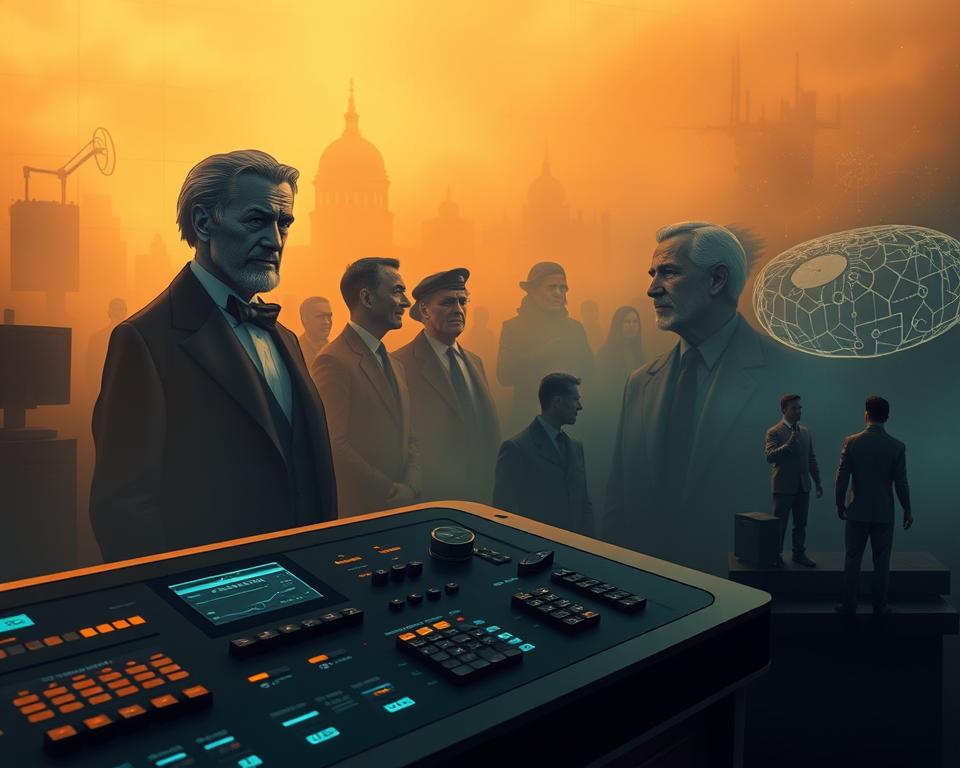
- Overpromised results failing to meet corporate or public demands
- Hardware too slow to handle complex algorithms
- Public skepticism after MIT’s 1976 report highlighted unfulfilled goals
The 2000s saw a comeback with three key moments:
- 2006: Geoffrey Hinton’s deep learning paper revived neural networks
- 2011: IBM’s Watson winning Jeopardy! reignited corporate interest
- 2012: AlexNet’s 15% error rate in image recognition proved neural networks’ worth
These moments show how setbacks led to smarter ways. Researchers moved to probabilistic methods and focused on specific tasks. By the 2010s, better hardware and cloud computing made early dreams possible.
Thanks to NVIDIA’s GPUs and open-source tools like TensorFlow, more people could join in. This shows that every setback is a step towards success.
The Impact of AI on Society and Industry
AI is changing how we work in many fields. Tools like predictive analytics and machine learning are now essential. They help us do our jobs better every day.
Revolutionizing Industries
Many sectors are seeing big changes. In healthcare, AI can find tumors with 95% accuracy, beating doctors. Banks use AI to catch fraud quickly, saving a lot of money.
Self-driving trucks and drones are changing how we move goods. They make delivery faster and cheaper.
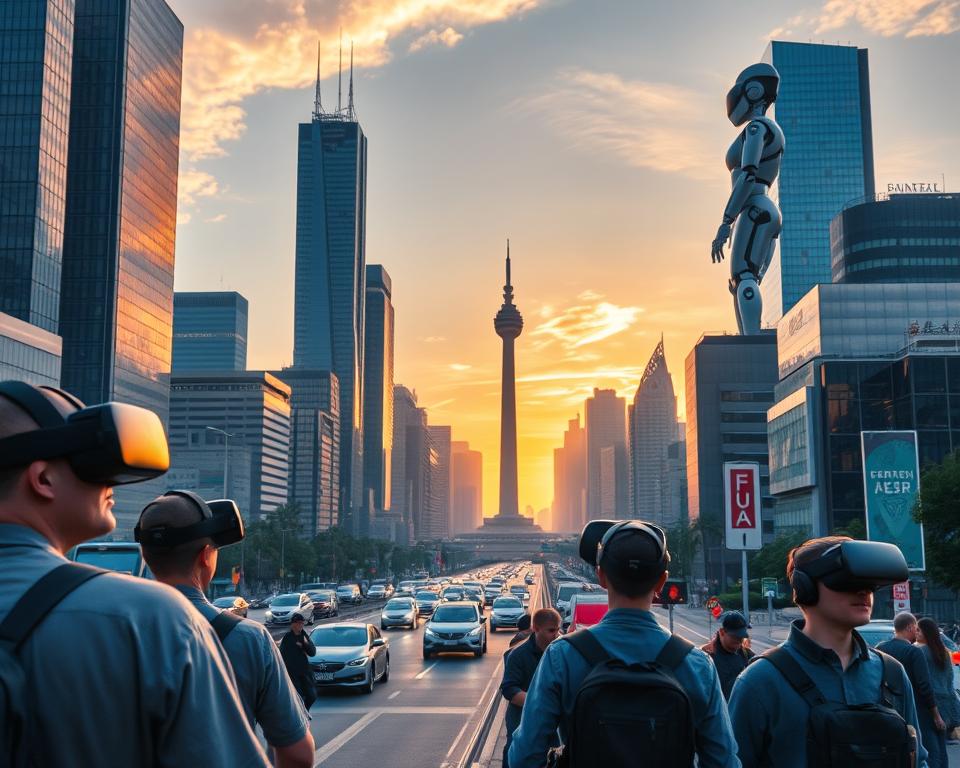
- Education platforms now adapt lessons to student performance, closing learning gaps.
- Manufacturing robots optimize assembly lines, cutting waste by up to 40% in some factories.
Evolving Social Perspectives
People have mixed feelings about AI. While 72% trust AI in medicine, 63% fear job loss. Debates over facial recognition and bias are common, leading to AI ethics rules.
Schools are teaching AI basics to get students ready for the future. This is a big change for our society.
“AI’s true value is in solving big human problems—not just making money.”
As AI gets smarter, we must balance its benefits with its risks. The growth of AI is not just about tech. It’s about how we work together as a global community.
Modern AI: From Machine Learning to Deep Learning
The crucial moments in AI evolution have sped up a lot in the 2010s. This is thanks to big leaps in deep learning. It all came down to two key things: huge datasets and super-fast computers like GPUs.
Companies like NVIDIA made special chips. These chips made training neural networks much faster. Now, systems can learn from raw data without needing to be programmed in detail.
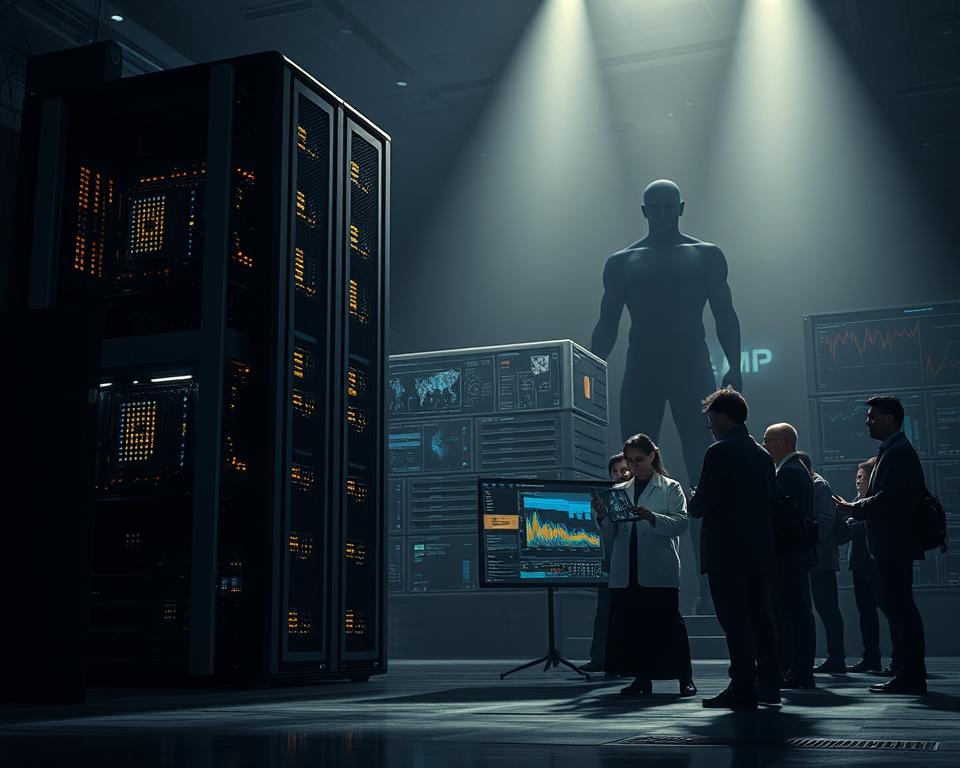
- Self-driving cars (Tesla) use neural networks to interpret road environments.
- Virtual assistants (Amazon Alexa, Apple Siri) leverage speech recognition powered by deep learning models.
- Healthcare systems now detect diseases via AI analyzing medical scans faster than human experts.
“Deep learning isn’t just an upgrade—it’s a paradigm shift,” said Andrew Ng, co-founder of Google Brain. “It unlocked capabilities once deemed science fiction.”
These big steps have changed many industries. Google’s AlphaGo beating a human Go champion in 2016 was a huge moment. It showed AI could tackle complex, abstract challenges.
OpenAI’s GPT series then changed how we talk to machines. It made chatbots and content generators better. Every step forward, from old algorithms to new systems, is a link in a chain of crucial moments. These moments shape today’s AI world.
Significant Milestones in AI and Their Global Influence
Groundbreaking algorithms and transformative technologies have changed how we see AI. These key moments, thanks to AI pioneers, have shaped our tech and policies globally.

Key Events Shaping the Future
Major achievements have caught the world’s attention and sparked AI investment:
- 1956 Dartmouth Conference: John McCarthy and Marvin Minsky started AI research here, introducing the term.
- 2011 Watson on Jeopardy!: IBM’s AI system won, showing it could answer questions in real time, boosting corporate use.
- 2016 AlphaGo: DeepMind’s AI beat a Go champion, showing deep learning’s power, leading to huge tech investments and global research.
Influential Breakthroughs and Legacy
Yann LeCun and Geoffrey Hinton’s work on neural networks opened up AI’s possibilities. Their deep learning research led to self-driving cars and medical breakthroughs. As Hinton said in 2020:
“The revival of neural networks opened doors to systems that learn like humans—this is AI’s foundation for the next century.”
These advances are changing healthcare and governance. Now, AI ethics are a top priority for policymakers. Industries worldwide are using AI tools. The work of AI pioneers continues to guide us towards new discoveries.
Conclusion
Artificial intelligence has come a long way, from Alan Turing’s early ideas in the 1930s to today’s AI friends. The Dartmouth Conference of 1956 named the field, starting a journey of innovation and challenges. Early programs like the Logic Theorist and tools like Lisp pushed the limits, but AI faced doubts when it didn’t meet expectations.
Now, machine learning and robotics power tools like Microsoft’s Copilot, changing industries. These tools, built on years of research, can do everything from data analysis to creative projects. But, there are big questions about ethics and reliability.
Pioneers like Mustafa Suleyman say we need to balance innovation with responsibility. This way, AI can truly benefit all areas of life.
The story of AI is one of never giving up and always being curious. From Turing’s Turing Test to today’s chatbots and smart devices, each step shows our determination to solve big problems. As AI keeps growing, its future depends on working together on technology, ethics, and what society needs.
This journey shows AI’s huge promise, but only if we make progress with care and thought.

